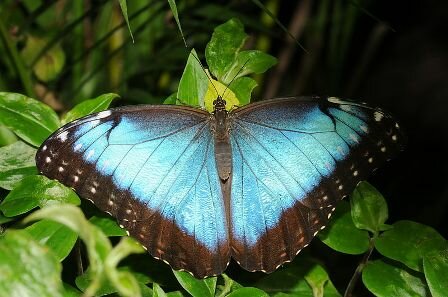One of these following facts about the Blue Morpho butterfly might probably give you much information about this animal. The Blue Morpho Butterfly, or also known as The Emperor Butterfly, is an iridescent tropical butterfly found in Mexico, Central America, northern South America, Paraguay, and Trinidad. Some authoritiesbelieve that this butterfly is a subspecies of Morpho helenor. The brilliant blue color in the butterfly’s wings is caused by the diffraction of the light from millions of tiny scales on its wings. It uses this to frighten away predators, by flashing its wings rapidly. Below are other facts about the Blue Morpho butterfly you might consider interesting.
Facts about the Blue Morpho butterfly 1: Name
As its common name implies, the blue morpho butterfly’s wings are bright blue, edged with black. The blue morpho is among the largest butterflies in the world, with wings spanning from five to eight inches.
Facts about the Blue Morpho butterfly 2: Appearance
Their vivid, iridescent blue coloring is a result of the microscopic scales on the backs of their wings, which reflect light. The underside of the morpho’s wings, on the other hand, is a dull brown color with many eyespots, providing camouflage against predators such as birds and insects when its wings are closed.
Facts about the Blue Morpho butterfly 3: Wings
The males’ wings are broader than those of the females and appear to be brighter in color. Blue morphos, like other butterflies, also have two clubbed antennas, two fore wings and two hind wings, six legs and three body segments — the head, thorax and abdomen.
Facts about the Blue Morpho butterfly 4: Habitat
Blue morphos live in the tropical forests of Latin America from Mexico to Colombia. Adults spend most of their time on the forest floor and in the lower shrubs and trees of the understory with their wings folded.
Facts about the Blue Morpho butterfly 5: Warming
Humans most commonly see morphos in clearings and along streams where their bright blue wings are most visible. Pilots flying over rainforests have even encountered large groups of blue morphos above the treetops, warming themselves in the sun.
Facts about the Blue Morpho butterfly 6: Diet
The blue morpho’s diet changes throughout each stage of its lifecycle. As a caterpillar, it chews leaves of many varieties, but prefers to dine on plants in the pea family. When it becomes a butterfly it can no longer chew, but drinks its food instead.
Facts about the Blue Morpho butterfly 7: Proboscis
Adults use a long, protruding mouthpart called a proboscis as a drinking straw to sip the juice of rotting fruit, the fluids of decomposing animals, tree sap, fungi and wet mud. Blue morphos taste fruit with sensors on their legs, and they “taste-smell” the air with their antennae, which serve as a combined tongue and nose.
Facts about the Blue Morpho butterfly 8: Threats
Blue morphos are severely threatened by deforestation of tropical forests and habitat fragmentation. Humans provide a direct threat to this spectacular creature because their beauty attracts artists and collectors from all over the globe who wish to capture and display them. Aside from humans, birds like the jacamar and flycatcher are the adult butterfly’s natural predators.
Facts about the Blue Morpho butterfly 9: Endangered Species
Experts opine the Blue Morpho butterfly is almost an endangered species. These butterflies are mainly affected by loss of natural habitat as a result of deforestation and other human activities. Additionally, they are also killed for their wings, which are used to manufacture jewelry. If people stop the destruction of their habitat and buying jewelry or ornamentation that involves the use of their wings, only then can there be some hope for their survival.
Facts about the Blue Morpho butterfly 10: Flying
When this butterfly is spotted flying, it is one of the most beautiful sights one can ever imagine. The flapping wings create a fine blend of the bright blue and dull brown colors, and the flashing colors create a beautiful effect.
Hope you would find those Blue Morpho butterfly facts really interesting, useful, and interesting for you to read.










 www.PortlandPayday.Loans
www.PortlandPayday.Loans